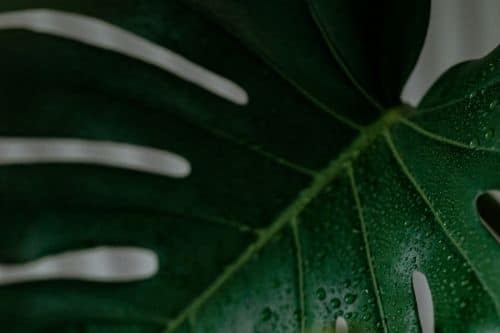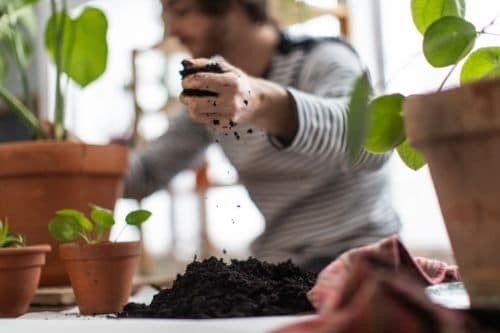Anyone who has ever observed their Monstera suddenly “sweating” and dripping water all over the place is likely to be concerned. Most plants don’t do this, so what on Earth is wrong with yours that has suddenly prompted this behavior? You might be wondering if it is under attack by pests or if it has some disease.
However, sweating is a normal process for a Monstera plant. It is known as guttation, and a Monstera uses it as a way of expelling excess water from its system so that it does not get overloaded. You don’t need to worry, but you might need to water your Monstera plant a little less if you notice this happening frequently.
What Is Guttation?
This term refers to the process that plants use to expel excess water from their tissues. Sometimes, a Monstera plant’s roots will take up more water than they can hold, usually because the soil that surrounds them is very wet.
They then need to get rid of this excess water. The pressure in the roots will trigger tissues called xylem tissues to start transporting water up into the plant and through its leaves. The xylem tissues are responsible for providing sap to the Monstera, so they have evolved to carry liquids.

Because there is too much water pressure, this will then force its way through the pores of the leaves, and start to drip down. It may look like your plant is crying, but really, it is just getting rid of the excess water that has got into its system, so the water pressure can go down and the roots can function normally again.
When Does Guttation Occur?
Guttation happens at night.
Usually, a plant gets rid of excess water via evaporation. This is permitted by the stomata, the leaf pores, which are open during the day. They allow water to slowly evaporate from the leaves, and they do not result in dripping.
However, at night, the stomata close, and then the pressure inside the leaves will build up until the water starts to leak out, instead of slowly evaporating. This causes the dripping that can look so alarming when you witness it for the first time. The water is coming out under pressure, rather than evaporating naturally away.
Do Other Plants Do This?
Yes, you might be surprised to learn that many household plants can and do use guttation as a means of getting rid of excess water in the leaves. This process helps them when they have absorbed more water than they can handle, and prevents the leaves from being damaged by excessive water pressure.
Does Guttation Have Any Disadvantages?
Some people are very worried by signs of guttation in a Monstera, but it is not necessarily anything to be concerned about. It may result in the loss of some sap, and you will probably find that you need to clean up around your plant – as the sap is sticky – but you don’t automatically need to be worried about this if it only happens occasionally.
Does Guttation Mean I Am Over-watering My Monstera?
This is the most logical conclusion to come to if you see signs of guttation, but it may not be the case. Guttation is directly related to water pressure, rather than to the quantity of water available to the plant.
In its simplest form, guttation is just a sign that your Monstera has absorbed more water than it can handle at that moment, and it needs to release this from the system to prevent damage from the pressure occurring.
However, guttation could be a sign that you are watering your Monstera too heavily. It can only occur when water is abundant, so if you see it frequently, it is worth checking if your watering schedule is okay.
You should water your Monstera only when the top inch of soil has dried out. This is the best way to minimize the risk of root rot. Do not leave your Monstera standing in water, and do not soak it every day.
If the soil does not seem to be drying out as you would expect, try to find out what is wrong, because this will endanger your plant. Guttation could be a sign of this, so if you witness it, it is a good idea to check how wet your plant’s soil is.
If it is very wet and you have not just watered it, there is a problem. The drainage of the pot has likely become blocked, or there is not enough drainage material in the soil.

When this happens, you need to take action. Remove your Monstera from its container, shake the soil off its roots, and then fill the bottom of the container with gravel. Allow the plant to dry out for a little while, or use a clean cloth to pat the roots dry if they are very wet.
Next, mix some perlite into the soil as you add it back into the pot (or use fresh soil). This will help the soil to drain and should ensure that the roots are not sitting in water for extended periods.
When Should I Worry?
It’s hard to know when to be concerned with a plant. You don’t want to be constantly stressing about your Monstera, but you also don’t want the plant to get sick because you are being too casual. When should you be concerned?
A good rule of thumb is that you can ignore guttation that happens on the same day as your plant was watered. Overnight guttation is nothing to worry about. However, if it continues the following night, you should check the plant. The soil should not be so wet at this stage that the roots are still under pressure.
If this is happening, check the drainage or reduce the frequency with which you water the plant so that it has time to dry out in between. You might also want to add less water to the container, as this should help to reduce how much the roots absorb on each watering.
Don’t ignore guttation that continues for more than a day after watering; it is a sign that something has gone wrong somewhere. A Monstera plant that has wet roots for long periods is at significant risk of root rot, which might kill the plant if ignored.
What Can You Do About Guttation?
Nobody wants water and sap all over the floor every morning, and if your plant seems to be weeping a lot, you might be wondering how to stop it. Fortunately, there are quite a few tricks you can try.
Tip One) Reduce Quantity And Frequency Of Watering
The best thing you can do is to reduce the quantity of water that you give to your plant each time. It can’t soak up too much water if it doesn’t have much.
This needs to be balanced so that your Monstera still has enough to drink.
Reducing the frequency with which you water will have the same result, and again needs to be balanced carefully. If you don’t give your Monstera too much water, it cannot soak up more than it can handle, and will not use guttation to get rid of it.
Tip Two) Contain The Mess
You can also put down cloths or a large tray beneath the Monstera the day that you water it. This should help to minimize the mess, catching the drops as they fall. If you find that you are regularly having to clean up around your Monstera, this may be a good idea.
It’s also wise to have your Monstera on a hard floor if possible, making cleanup easier. If you keep your Monstera on a carpeted floor, put something beneath it to protect the carpet from guttation.
Tip Three) Reduce Humidity
Monstera plants usually get rid of excess water by allowing it to evaporate through their pores during the day. However, they cannot do this if the air is very humid, because the water will not be able to evaporate effectively.
Although Monstera plants do like humidity, reducing it a bit can help them to lose more water through their leaves when they need to. Consider installing a hygrometer near your plant so that you can keep an eye on the humidity levels and reduce them when necessary.
Tip Four) Increase Light

Guttation only occurs at night, when the plant’s stomata have closed. If you help your plant to keep its stomata open for longer, more water can evaporate into the air, rather than forcing its way through closed pores as a liquid.
Increasing the amount of light available to your Monstera will encourage it to keep its pores open for longer, helping the moisture in the leaves evaporate effectively. You can use a grow light or move your Monstera into a different room, where more light is available.
Tip Five) Improve The Soil Drainage
If your plant’s soil does not drain properly, it will end up sitting in moisture for days. Worse, if it drains unevenly and some parts stay wetter than others, you won’t be able to tell when your plant does and does not need watering.
This can result in the soil getting increasingly damp without you even realizing it because the surface is dry. If you are having problems with guttation, it’s a good idea to take your Monstera out of its pot and see what is going on.
If you have pockets of moisture, you need to improve the drainage. Gravel, perlite, and orchid bark all help to make sure the soil drains. Vermiculite is another option, but this holds onto water and releases it slowly.
This can stop a Monstera from taking up too much water at once, but bear in mind that you won’t need to add water to the pot as often if you are using vermiculite.
Check that your container has large enough drainage holes, and re-pot your Monstera with the improved drainage.
Conclusion
Guttation is not a definite sign that something is wrong, but if you notice your Monstera “sweating” frequently, you should check that it is not being over-watered. An occasional need to expel excess water should be fine, but regular and ongoing guttation should concern you. Make sure you aren’t over-watering, and that your plant has good drainage.

